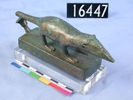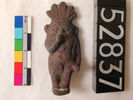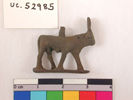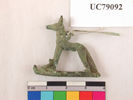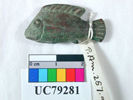Late Period: bronze figures
Background: bronze figures before the Late Period
Metal figures are mentioned already for the Second Dynasty on a fragment of the 'Palermo Stone'. From the Old Kingdom (about 2686-2181 BC) survived the copper figures of Pepy I, found at Hierakonpolis. In the Middle Kingdom (about 2025-1700 BC) some small scale bronze figures, both royal and private, are known (see UC 8253), and equally few metal figures and statues are known from the New Kingdom (about 1550-1069 BC). The Third Intermediate Period saw high quality production on an impressive scale; the statues of some royal women are particulary celebrated, notably that of queen Karomama now preserved in the Louvre.
Bronze figures in the Late Period: mass production
In the Late Period small bronze statues (donations of private persons to
temples) were produced in very high numbers. Most such bronzes in museums
are without provenance; some were found in deposits (for example the 600 figures
found in a wooden box at Abydos, and the thousands retrieved from the Karnak
cachette, in the open court south of the great Amun temple). The bronzes seem
to have been produced at a number of local centres and then taken to different
temples; this, at least, would explain why the bronzes at one site may display
a wide range of styles. Roeder
1956 (:542) distinguished Upper, Middle and Lower Egyptian styles especially
of Osiris figures, but this hypothesis has yet to be securely established.
Technology: most of the bronzes are cast.
Iconography: different deities may be depicted with the same attributes, and the same deity may be depicted in more than one form, to show different aspects. Often a form is specific in the Late Period to a particular local deity. Therefore form alone is not usually enough to identify a figure in ancient Egyptian formal art: geographical context (provenance) and/or inscription are the more reliable criteria for identification of the name intended by the ancient artist.
|
cat headed
goddess (Bast?)
|
Imhotep
|
shrewmouse (the blind vulnerable Horus)
|
Min and Horus
|
god with falcon head and double plume (Mont?)
|
|
|
regal child god
|
regal child god
|
moon god (Osiris-Iah?)
|
goddess with red crown (Neit?)
|
torso of a larger Osiris figure
|
|
aegis with head of goddess
|
Bes
|
sacred bull
|
jackal on standard (Wepwawet?)
|
tilapia fish
|
Further reading:
|



